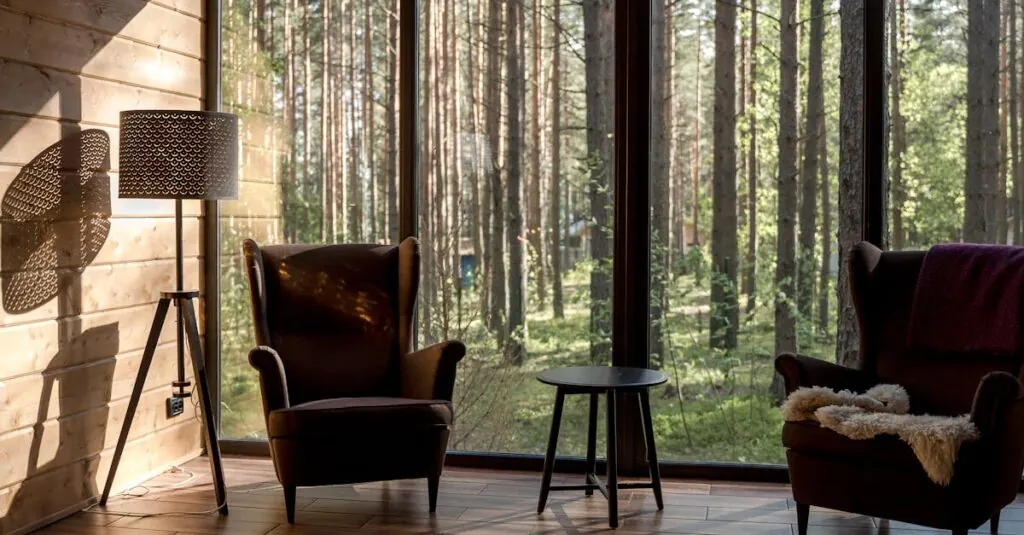Table of Contents
ToggleImagine transforming your home into an eco-friendly sanctuary while saving the planet and your wallet. Sounds like a win-win, right? With a few clever upgrades, they can turn their humble abode into a green machine. From energy-efficient appliances that don’t just hum a tune but also cut down on those pesky utility bills to stylish solar panels that make neighbors green with envy, the options are endless.
Benefits Of Eco-Friendly Home Upgrades
Eco-friendly home upgrades present numerous benefits. They contribute positively to the environment while enhancing a homeowner’s quality of life and savings.
Energy Efficiency
Improved energy efficiency leads to lower utility bills. Energy-efficient appliances consume less electricity, allowing for significant cost savings over time. Upgrading insulation or windows enhances a home’s temperature regulation, minimizing the need for heating and cooling. Using smart home technology optimizes energy use, adjusting settings based on occupancy. These upgrades offer comfort and contribute to a sustainable lifestyle.
Reduced Carbon Footprint
A reduced carbon footprint results from eco-friendly upgrades. Solar panels generate clean energy, decreasing reliance on fossil fuels. Utilizing renewable energy sources lessens greenhouse gas emissions, crucial for a healthier planet. Implementing water-saving fixtures cuts down on water usage, further minimizing environmental impact. Each conscious choice made in home upgrades promotes a more sustainable future, benefitting both the homeowner and the environment.
Popular Eco-Friendly Home Upgrades
Homeowners increasingly seek eco-friendly upgrades to enhance sustainability and reduce costs. Several options stand out for their effectiveness and appeal.
Solar Panels
Solar panels play a crucial role in reducing energy costs. They capture sunlight and convert it into electricity, significantly lowering monthly utility bills. Installing solar panels can diminish reliance on fossil fuels. Depending on the size of the system, homeowners report savings of 50% or more. Many local governments offer incentives that reduce installation costs. Upfront investments often pay off within a few years, leading to long-term financial benefits. Additionally, solar panels increase home value, making properties more attractive to potential buyers.
Energy-Efficient Appliances
Energy-efficient appliances help lower energy consumption while providing the same performance as traditional models. These appliances use advanced technology to minimize power usage and reduce greenhouse gas emissions. Products with the ENERGY STAR label often consume 10-50% less energy compared to standard appliances. For instance, energy-efficient refrigerators and washing machines significantly cut costs over time. Homeowners benefit from lower utility bills and enhanced functionality. Many utilities provide rebates for choosing energy-efficient options, further encouraging sustainable choices. Upgrading appliances streamlines daily tasks while promoting environmental responsibility.
Cost Considerations
Investing in eco-friendly home upgrades involves understanding both upfront costs and long-term financial gains. Homeowners should evaluate how these improvements fit into their budgets while considering potential savings.
Initial Investment
Initial costs vary based on the type of upgrades chosen. Solar panel installation ranges from $15,000 to $25,000, which many homeowners finance through incentives or low-interest loans. Energy-efficient appliances generally cost 10-30% more than traditional models but significantly enhance performance. Smart home technology can also require upfront investments, usually between $200 and $1,500. Combining these options can lead to greater overall savings, with some upgrades offering quick returns on investment.
Long-Term Savings
Long-term savings from eco-friendly upgrades prove substantial. Homeowners often experience energy cost reductions of 20-50% after installing solar panels, leading to significant monthly savings over the system’s lifespan. Efficient appliances typically reduce energy consumption by 10-50%, which translates to lower utility bills. Additionally, improved insulation and windows contribute to enhanced heating and cooling efficiency, saving an estimated 15% on energy costs. Over several years, these upgrades can generate savings that surpass initial investments, resulting in lower financial burdens and a positive impact on the environment.
DIY Eco-Friendly Upgrades
Making simple changes at home can greatly improve its sustainability. Small adjustments can lead to significant impacts. Replacing incandescent bulbs with LED lights not only uses 75% less energy but lasts up to 25 times longer. Adding weather stripping around doors and windows reduces drafts, enhancing comfort and lowering heating and cooling costs. Homeowners often find that reducing water usage can start by installing low-flow showerheads or faucets, which can save 30% on water bills.
Using sustainable materials for home upgrades reflects a commitment to the environment. Many homeowners prefer reclaimed wood for furniture or flooring, which reduces waste and provides a unique aesthetic. Bamboo serves as another excellent choice with its rapid growth and renewability. When renovating, opting for non-toxic paints prevents harmful chemicals from entering indoor air quality and protects the environment. Eco-friendly insulation options, such as cellulose and sheep’s wool, enhance energy efficiency while using renewable resources.
Professional Services For Eco-Friendly Upgrades
Professional services play a crucial role in executing eco-friendly home upgrades. Choosing the right help ensures seamless implementation of energy-efficient solutions.
Choosing The Right Contractor
Selecting a contractor requires careful consideration. Start by reviewing portfolios to assess their experience with eco-friendly projects. Look for professionals who specialize in sustainability and energy-efficient upgrades. Recommendations from trusted friends or online reviews also provide valuable insights. Bren the financial implications into account; obtaining multiple quotes can help identify competitive pricing. Ultimately, communicate clearly about specific needs to guarantee alignment throughout the project.
Certifications To Look For
Certifications indicate a contractor’s commitment to industry standards. Prioritize certifications such as LEED (Leadership in Energy and Environmental Design) when selecting a professional. Numerous organizations offer credentials focused on sustainability and energy efficiency—these certifications reflect knowledge of best practices. Additionally, consider looking for EPA (Environmental Protection Agency) certifications related to energy-related upgrades. Verification of credentials can establish trust and credibility, ensuring adherence to eco-friendly practices during home upgrades.
Conclusion
Embracing eco-friendly home upgrades isn’t just a trend; it’s a vital step toward a sustainable future. Homeowners can significantly reduce their environmental impact while enjoying long-term financial benefits. By investing in energy-efficient appliances, solar panels, and smart home technology, they create a more comfortable living space and lower utility bills.
Simple DIY projects can also make a big difference, proving that sustainability is achievable for everyone. With the right professional guidance and a commitment to green practices, transforming a home into an eco-friendly haven becomes a rewarding journey. Ultimately, these upgrades reflect a homeowner’s dedication to both their finances and the planet, paving the way for a healthier lifestyle and environment.







